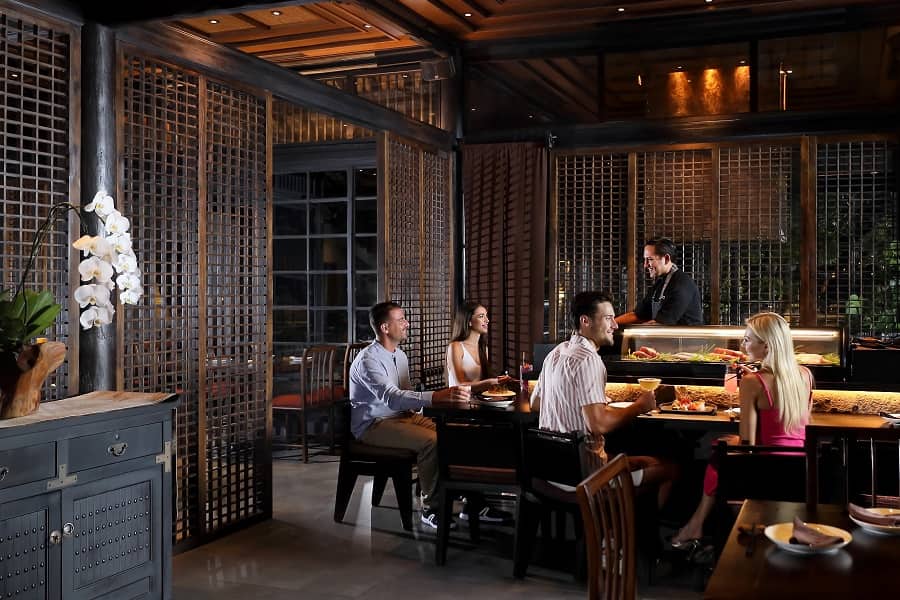Japanese cuisine has captured the hearts and taste buds of people worldwide, but it’s not just the food that makes dining in a Japanese restaurant so special. The ambiance plays a vital role in creating a unique and immersive experience. Japanese restaurants are known for their serene and calming ambiance, reflecting the Zen philosophy that celebrates simplicity, mindfulness, and a deep connection with nature. Join us on a journey as we explore the tranquil world of restaurant ambiance and how it sets the stage for an exceptional dining experience.
- Serene Minimalism
Japanese restaurant ambiance is characterized by serene minimalism. The decor is simple, clean, and uncluttered. Neutral colors, such as earthy tones and soft grays, create a sense of tranquility. The use of natural materials, like wood and stone, adds warmth and a connection to nature.
- Soothing Lighting
Lighting in Japanese restaurants is soft and gentle. Paper lanterns, shoji screens, and carefully placed ambient lighting create an atmosphere that is both relaxing and inviting. The play of shadows and glows adds depth and dimension to the decor, enhancing the overall sense of calm.
- Natural Elements
Japanese restaurants often incorporate natural elements into their decor. Bonsai trees, bamboo, and indoor gardens can be found throughout the space. These elements evoke a connection to the natural world and contribute to the overall ambiance of tranquility.
- Tatami Seating
Traditional Japanese restaurants offer tatami seating, where diners sit on mats placed directly on the floor. This seating arrangement encourages mindfulness and a deeper connection with the dining experience. It’s a reminder to slow down and savor the meal.
- Zen Gardens
Some Japanese restaurants feature miniature Zen gardens, which are arrangements of sand, stones, and raked patterns. These gardens are not only visually pleasing but also symbolize the importance of simplicity, balance, and serenity in life.
- Musical Harmony
The choice of music in Japanese restaurants is carefully curated to enhance the ambiance. Traditional Japanese instruments like the koto or shamisen, or the soothing sounds of nature, contribute to the tranquil atmosphere. The music is played at a volume that allows for conversation without intruding on the peacefulness of the space.
- Culinary Artistry
Japanese cuisine is not just about the flavors but also about the artistry of presentation. Dishes are meticulously crafted, and the use of vibrant colors and beautiful plating adds to the overall ambiance. The focus on culinary artistry encourages diners to appreciate the aesthetics of their meal.Elevate your diners’ experience and exceed their service expectations with the power of a restaurant OS.
- Teahouse Aesthetics
The influence of traditional teahouses is evident in many Japanese restaurants. The teahouse aesthetics embrace the principles of wabi-sabi, which is the acceptance of imperfection and transience. This is reflected in the decor, where subtle imperfections and handmade elements are celebrated.
- Impeccable Service
Service in Japanese restaurants is marked by professionalism and attentiveness. The staff is knowledgeable about the menu, the cultural significance of dishes, and the importance of hospitality. They create an atmosphere of mindfulness and respect for the diner’s experience.
- Seasonal Significance
Japanese restaurants often place a strong emphasis on seasonal ingredients and dishes. The menu changes with the seasons, and this reflects an appreciation for the cycles of nature and a connection to the natural world. It adds depth to the dining experience and encourages diners to be mindful of the changing seasons.
- Traditional Rituals
Some Japanese restaurants incorporate traditional rituals into the dining experience. For example, the preparation and presentation of tea, known as the Japanese tea ceremony or chanoyu, is an intricate ritual that can be performed in certain establishments. These rituals underscore the importance of mindfulness and respect for traditions.
- Sake and Beverage Choices
Sake, a traditional Japanese rice wine, is often a central feature of the beverage menu in Japanese restaurants. The careful selection of sake and other beverages complements the cuisine and enhances the overall ambiance. Sake can be served in traditional ceramic cups, adding an extra layer of authenticity to the experience.
In Conclusion: A Journey of Tranquility
Japanese restaurant ambiance is a journey of tranquility, where every element, from decor to service, from lighting to culinary artistry, comes together to create a dining experience that is more than just a meal. It’s an opportunity to immerse oneself in a world of serenity, mindfulness, and appreciation for the beauty of simplicity.
Dining in a Japanese restaurant is not just about the food; it’s a celebration of the ambiance that embodies the Zen philosophy and the cultural richness of Japan. So, the next time you find yourself in a Japanese restaurant, take a moment to appreciate the thoughtful ambiance, for it’s an integral part of the tranquility and harmony that awaits.

